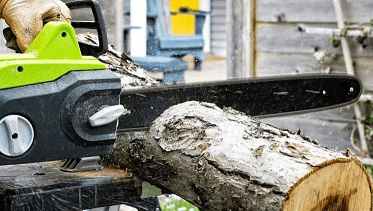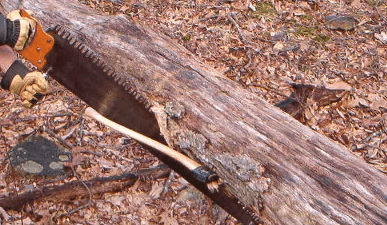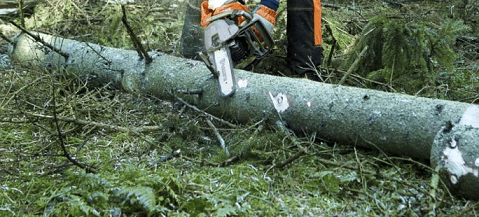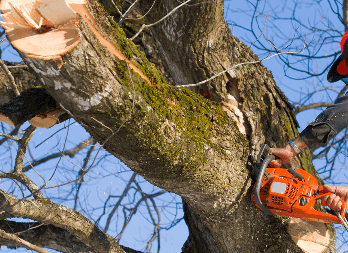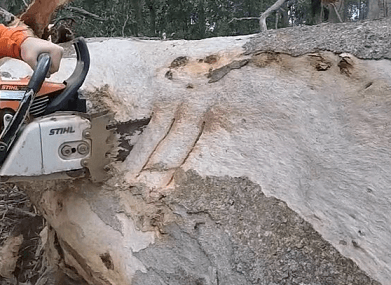Chainsaws are potentially dangerous power tools. So, you need to have some basic skills and training to use a chainsaw to cut down wood. It is important to know how to position yourself and use the correct technique to cut the trees.
The correct technique depends on whether you need to cut the entire or a part of the tree such as its limbs or branches. Additionally, you also have to consider whether you need a horizontal cut or a vertical cut.
Below are the different chainsaw cutting techniques you can use to cut down the trees effectively,
Outline
ToggleOverbucking Chainsaw Technique
Also known as overcutting, this is the most popular technique for cutting trees. The technique is used to cut down a horizontal log of wood. In this, you cut down the wood log through the top of it.
Underbucking Chainsaw Technique
Also known as undercutting, this is the exact opposite of the overbucking technique. In this, you cut down the log through the underside. Using this technique, you can cut the wood faster. It takes ⅔ of the time of overbucking technique. Also, the chainsaw does not get stuck on the log when you use this technique.
Limbing Trees Chainsaw Technique
As the name implies, this technique removes limbs from the fallen trees. The technique requires a certain skill and you have to be very cautious.
First, you will have to cut the branches and limbs that do not support the tree. These include branches on the top, sides, and the smaller limbs on the undersurface of the tree. The tree will still be in the same position after you have removed these limbs.
Now, examine the other limbs and find out which way the tree will roll once you cut these limbs. Stand in the opposite direction and start cutting the limbs. Also, make sure no one is standing in the direction the tree would roll.
Pruning Trees Chainsaw Technique
The pruning technique cuts down the limbs and branches when the tree is in its upright position.
First, you have to identify the branches that you need to remove. Then start undercutting the branch. Do not cut it completely and remove the branch. Cut it to about ⅓ of its size. Make the cut at a distance of 1 foot from the trunk.
After this, overcut the branch about 3 inches from the previous cut. This will reduce the load on the tree. Now, make a final overcut close to the trunk and remove the branch.
When you use this technique, never cut the branches above your shoulder height. Use a support that has a large base to stand instead of a ladder.
Cross-Cutting Chainsaw Technique
Using the cross-cutting technique, you can cut logs that are supported at both ends. The technique prevents the chainsaw from getting pinched when you are cutting the log.
First, cut vertically about one-third of the way into the log. Then, cut the log from the underside of it until you reach the first cut. Before you reach the first cut, the weight of the log will cause it to split through the cut.
One major problem with this technique is that it will cause a kickback. You should plant your feet and secure the chainsaw firmly to prevent it.
Also check –
Technique to Cut Logs supported at One End
Similar to the previous techniques, undercut the log about one-third vertically through its size. Now, cut it from the top until the log splits through the cut. Cutting it from both sides ensures that the chainsaw does not get stuck.
Technique to Cut Log on the Ground
If you want to cut a log rested on the ground, you can use the overcutting technique. Simply, cut the log from the upper surface until it is split. Do not allow the chainsaw to touch the ground. Or else, it will cause a kickback.
The main problem with this technique is that the chainsaw will get stuck in the wood. To release it, first, turn off the chainsaw. Then, drive a wedge into the cut to release the tension. Now, you can remove it from the log.
You can then continue with the same technique to cut the log.
Technique to Cut Log on a Hill
The main thing when it comes to cutting a tree on a hill is your positioning. You should always stand facing towards the slope. So that, even if the fallen tree rolls over, you will not get hurt.
Chainsaw Stump Cutting Technique
It is difficult to cut a tree stump as it can be firm. However, this is one of the easiest methods to cut the stump.
First, remove the dust and debris lying on the ground around the stump. You can use a blower for this purpose. Removing this debris will ensure the chainsaw does not get damaged.
Now, make a horizontal cut as close to the ground as possible. There is a high chance for kickback as it is close to the ground and you may hit the ground. So, hold the chainsaw steady until it cuts the stump. Additionally, there is also a chance for the saw to get stuck. In such a case, use a wedge to release the chainsaw.
Safety Tips while Chainsaw Cutting
Safety is the first thing that should come to your mind while cutting wood using a chainsaw. Below are some of the safety tips to follow to prevent the occurrence of any unfortunate incidents.
- Wear protective gear before you start using the chainsaw. The protective gear includes helmets, gloves, and steel-toed boots.
- Keep your feet planted firmly in the ground. Additionally, secure the chainsaw with a strong grip.
- Never cut trees above your chest height. It will help prevent kickbacks.
- If you are cutting a tree on a hill, always position yourself facing towards the slope.
- Use a combination of overbucking and underbucking techniques to ensure your chainsaw does not get stuck.
- When cutting fallen trees, first remove branches that don’t support the tree. Then, remove the ones that support the tree.
- When you cut a tree, you will not know which side the tree will fall. So, examine your surroundings before cutting the tree. Then, be quick to move into a safe location when the tree falls.
- If your chainsaw gets stuck, first turn it off. Then, use a wedge to release the pressure and retrieve the chainsaw.
Frequently Asked Questions
Use a combination of overbucking and underbucking techniques to prevent your chainsaw from pinching. First, overcut to about one-third of the log’s diameter. Then, undercut the log and split it through the overcut. Using this, you will be able to cut a tree without pinching.
Your chainsaw will stop cutting if the blade becomes dull. In that case, you will have to sharpen the blade. The other common reason is if the chain is too tight. The chain will not rotate at normal speed and hence, will not cut properly. In this case, you have to loosen the tension and adjust the chain.
First, you will have to remove debris around the stump to prevent your chainsaw from getting damaged. Then, make a horizontal cut as close as possible to the ground. Hold the saw firmly until it cuts the entire stump.
Yes, you can split logs with a chainsaw. You can either use overbucking or underbucking techniques to split the logs. Underbucking is faster than overbucking and takes only two-thirds of the time of the overbuck technique.
To cut large logs, first, you have to overcut the log to about one-third of its diameter. Then, you have to undercut it through the first cut until the log splits and falls off.
Conclusion
As you have seen, most methods of chainsaw cutting involve a combination of overbucking and underbucking. You will have to first overcut the wood to about one-third. Then, undercut the wood through the first cut until it splits.
Additionally, you must use a chainsaw that is 2 inches more than the diameters of the wood.
If you have any queries or doubts, let us know using the comments section. We will help you out. You can also post your thoughts and opinions in the comments box.

